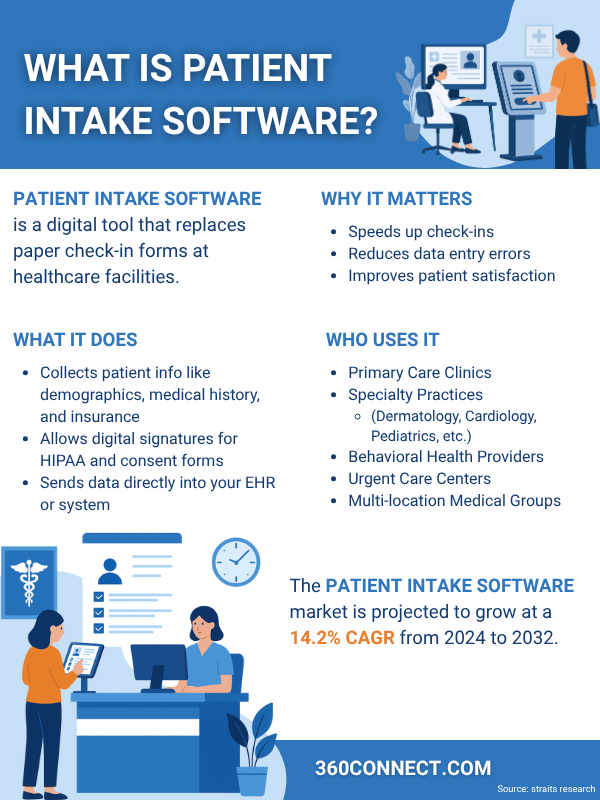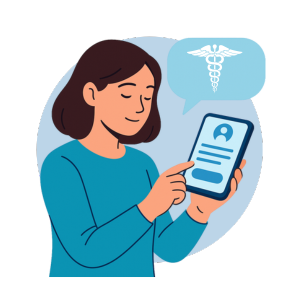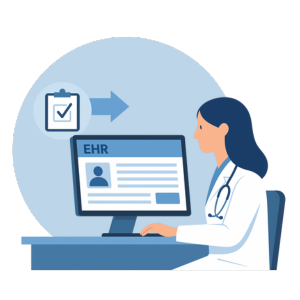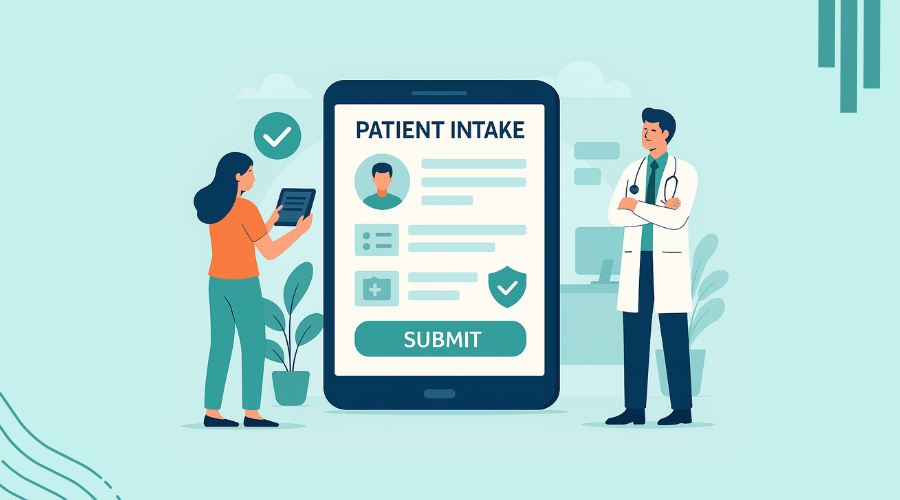If you work in healthcare, you already know how hectic the front desk can get. Between managing paperwork, greeting patients, and verifying insurance, your staff barely has time to breathe. That’s where patient intake software comes in. It’s designed to simplify and automate the check-in process, saving time, improving accuracy, and helping practices focus on what matters most: patient care.
So, what exactly is patient intake software? And why are so many healthcare practices switching to it? Let’s break it down.
Related: What is the Most Commonly Used Medical Software?
What is Patient Intake Software?
Patient intake software is a digital tool that replaces traditional paper intake forms. It allows patients to fill out personal information, medical history, insurance details, consent forms, and more, usually before they even walk through your door.
Instead of handing a clipboard to every new patient, your practice can collect accurate, legible data through an online portal, tablet, or kiosk. The information goes directly into your system, reducing errors and cutting down on wait times.
Whether you run a small family clinic or a large specialty practice, this software helps modernize your workflow and gives patients a smoother, more professional experience.

Who Uses Patient Intake Software?
Patient intake software is used by a wide range of healthcare providers looking to modernize their front-office experience and streamline operations. It’s especially valuable for:
- Primary care practices that want to reduce paperwork and improve patient flow
- Specialty practices like dermatology, cardiology, pediatrics, and more, where detailed medical histories are key
- Behavioral health providers who often operate solo and benefit from remote intake options
- Urgent care centers that require quick, accurate patient information for faster service
- Multi-location medical groups that need consistent intake processes across offices
Whether you’re running a small clinic or managing a large healthcare organization, patient intake software can adapt to your needs and scale with your growth.
How Does Patient Intake Software Work?
Now that you know what patient intake software is and who uses it, let’s look at how it actually works in a real-world setting. The process is typically straightforward but highly effective when implemented well.

1. Pre-Appointment Intake
After scheduling an appointment, patients receive a secure link via text or email, allowing them to complete intake forms at their convenience from a smartphone, tablet, or computer. These forms often include demographic information, medical history, current medications, and insurance details. By allowing patients to fill out forms ahead of time, your staff saves time, and patients get a head start on their visit.

2. Digital Signatures & Consent Forms
Once patients complete the forms, they can sign required documents electronically, such as HIPAA disclosures, financial agreements, and consent for treatment. This digital process ensures that every document is properly completed and time-stamped, helping your practice maintain compliance and reducing the need for paper storage.

3. Automatic Uploads to EHR/Practice Management System
After submission, all data is automatically uploaded into your Electronic Health Record (EHR) or practice management software. This integration reduces manual entry errors and ensures that providers have immediate access to accurate, up-to-date patient information when the appointment begins.

Additional Features That Streamline Front Desk Operations
Beyond the core workflow, many patient intake platforms include helpful features designed to further improve both staff efficiency and patient satisfaction. These may include real-time insurance eligibility checks to confirm coverage before a patient even arrives, photo ID capture for quick verification, co-pay collection tools that allow for prepayment or easy processing, and automated appointment reminders to reduce no-shows.
When combined, these features not only reduce administrative burdens but also create a smoother, more connected front-desk experience from start to finish.
Benefits of Using Patient Intake Software
With a better understanding of how the process works, it’s easy to see why practices of all sizes are adopting this software. Here’s a closer look at the benefits it brings to the table:
Faster Check-Ins
With digital intake, patients can complete their paperwork before arriving, which significantly cuts down on waiting room time. They can walk in, get verified quickly, and move on to their appointment without unnecessary delays. This also helps your office stay on schedule and reduces bottlenecks during busy hours.
Improved Data Accuracy
Traditional paper forms often lead to mistakes due to illegible handwriting or skipped fields. Patient intake software ensures that data is entered clearly and completely. Required fields can’t be skipped, and digital entry removes transcription errors when front desk staff enter data manually into your system.
Better Staff Productivity
When intake is automated, your staff can focus on higher-value tasks like patient service, scheduling, and follow-ups. Instead of spending hours entering data or chasing down forms, they can shift their attention to running the front office smoothly and efficiently.
Enhanced Compliance
Patient intake software often includes built-in safeguards to ensure your forms are HIPAA-compliant. Digital signatures and time-stamped records make audits easier and more accurate. It also reduces the chances of misplaced or improperly stored documentation.
Happier Patients
The intake process is often the first impression a patient has of your practice. A smooth, digital experience helps build trust and confidence from the start. It shows patients that your practice values their time and embraces modern tools that make healthcare easier.
Choosing the Right Patient Intake Software Provider
Once you’re ready to explore solutions, the next step is finding the right fit for your practice. Here are a few patient intake software providers worth considering:
Phreesia
Best for: Larger practices needing robust customization
Why it stands out: Offers check-in kiosks, insurance validation, and digital payments.
RXNT
Best for: Practices looking for an all-in-one medical software suite
Why it stands out: Offers integrated digital intake as part of its EHR + PM platform, making it ideal for practices that want everything under one roof.
NexHealth
Best for: Practices looking for end-to-end patient engagement
Why it stands out: Combines intake, scheduling, reminders, and reviews in one platform.
Kareo
Best for: Independent practices
Why it stands out: Affordable, intuitive, and integrates well with their EHR and billing systems.
SimplePractice
Best for: Behavioral health and solo providers
Why it stands out: Clean interface, HIPAA-compliant forms, and great for remote intake.
Note: Not every software platform is one-size-fits-all. The right solution depends on your practice size, specialty, and workflow. If you’re not sure where to start, consider working with an online marketplace to compare your options and get matched with a provider that fits your exact needs.
Is Patient Intake Software Needed?
You might be wondering, “Do I really need another system?” It’s a fair question. But consider how much time your team spends sorting through paper forms, entering data, correcting mistakes, or tracking down incomplete files. Now imagine reclaiming that time and using it to improve the patient experience instead.
Patient intake software isn’t just a nice-to-have; for many practices, it’s become essential. It helps eliminate repetitive tasks, reduce administrative errors, and ensure smoother workflows. As patient expectations shift toward more digital-friendly experiences, offering a modern, efficient check-in process can also give your practice a competitive edge.
Additionally, the patient intake software market is projected to grow by a 14.2% compound annual growth rate (CAGR) from 2024 to 2032. This is a clear signal that these digital tools are becoming the norm, not the exception.
In short, if you’re looking to increase efficiency, improve accuracy, and offer a better patient experience, all while supporting your team, then yes, patient intake software is a smart investment.
Final Thoughts on Patient Intake Software
Switching to patient intake software might feel like one more change on an already full plate. But the payoff is worth it. With fewer delays, smoother check-ins, and less room for error, both your staff and your patients will benefit.
Whether you’re just starting to explore options or you’re ready to make the switch, now’s the time to invest in the tools that streamline your operations and elevate the patient experience.
Compare Medical Software Quotes Today
Looking for the right solution for your practice? 360Connect makes it easy to compare personalized medical software quotes, all in one place. Get matched with trusted providers who understand your needs and can help you implement the right system.

